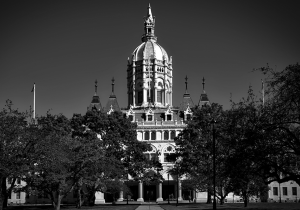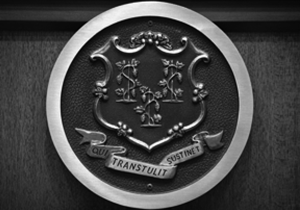(HARTFORD, CT) – Governor Ned Lamont, Treasurer Erick Russell, and Comptroller Sean Scanlon today announced that more than $1.3 billion captured from volatile revenue sources over the last fiscal year is being transferred to pay down Connecticut’s pension debt.
Budgetary reforms enacted in 2017 and extended this year through legislation signed by Governor Lamont require the state to deposit excess revenue from particularly volatile categories, such as portions of the personal income tax and pass-through entity tax, in the Budget Reserve Fund, commonly known as the Rainy Day Fund. A total of $2.5 million of this volatility transfer will be placed in reserves, bringing the fund to its statutory cap. The remainder will be deposited in the pension funds for retired state workers and Connecticut teachers.
Approximately $1.05 billion will be directed to the State Employees Retirement System. The remaining $272.8 million will be deposited in the Teachers’ Retirement System. The fiscal year 2023 budget surplus, projected to be more than $500 million, will also be directed to the Teachers’ Retirement System after an audit of fiscal year-end financials has been completed later this year.
Since the advent of these reforms – part of the state’s “fiscal guardrails” – more than $7 billion in excess contributions have been made to pay down pension debt, resulting in future savings for Connecticut taxpayers. This is the fourth consecutive fiscal year that additional contributions have been made to pay down pension debt.
Governor Lamont said, “Connecticut is making significant progress in addressing a decades-long underfunding of its pension system, saving taxpayers more than $600 million per year over the next 25 years. The bipartisan extension of the fiscal guardrails is why we are able to put another $1.3 billion this year toward the state’s unfunded pension liabilities, on top of the $5.8 billion previously transferred. Members of the General Assembly, both Democrats and Republicans, have committed themselves to continuing the progress that has been made and should be applauded for their joint efforts. We have more work to do – now is not the time to lose focus and declare mission accomplished. Connecticut leaders must remain steadfastly committed to sound fiscal management practices, maintaining the fiscal guardrails, and adhering to the spending cap. We owe it to our residents, businesses, children, and grandchildren to leave our state in far better financial shape than we found it.”
Treasurer Russell said, “This infusion of funds will bolster the progress we’ve made in strengthening our pension funds and maximizing investment performance. The reforms we’ve made to our investment strategy are already showing promising results, with strong year-end numbers released this month, but overcoming decades of unaddressed debt and underfunding is a long-term endeavor. The fiscal guardrails have been undeniably successful in enhancing Connecticut’s economic standing and have earned us a national reputation for our bipartisan commitment to fiscal discipline. It’s critical we maintain this momentum as we continue to shape a prosperous and strong economic future for our state.”
Comptroller Scanlon said, “The fiscal reforms we’ve put in place are working, and Connecticut’s fiscal health is the strongest it has been in decades. For too long, both parties kicked the can to future generations, and our pension debt grew and grew. Those days are over, and today’s transfer of $1.3 billion – on top of the almost $6 billion transferred in the last four years – is proof that we are making real progress when it comes to paying down our debt and getting our fiscal house in order.”
Senate President Martin M. Looney (D-New Haven) said, “This is superb news about Connecticut’s fiscal health. It may also open opportunities for us in the upcoming 2024 legislative session for some investments in social and educational needs that have been struggling since we’ve been in deficit.”
House Speaker Matt Ritter (D-Hartford) said, “I am incredibly proud to have been part of the team in 2017 that set the fiscal guardrails in place. Paying down the state’s pension debt is freeing future generations from an incredible burden, and we are supporting retirement benefits for state troopers, professors, nurses, correction officers and more.”
Senate Majority Leader Bob Duff (D-Norwalk) said, “This is great news which reflects all the hard work and fiscal responsibility that Connecticut has engaged in over the past decade to get our legacy pension debt under control. The volatility cap has proven to be a great financial tool to help pay down the long-term pension obligations that were ignored for the past 60 or 70 years.”
Senate Minority Leader Kevin Kelly (R-Monroe, Seymour, Shelton, Stratford) said, “Senate Republicans were instrumental in the creation of the smart fiscal guardrails and spending caps back in 2017, and it was Republicans who pushed to renew and extend these budgetary guardrails this year. This spending discipline has created our surpluses, improved our financial position, and led us to the first state income tax cut in three decades. We must preserve and maintain these wise financial practices for years to come.”
House Majority Leader Jason Rojas (D-East Hartford) said, “While enormous progress has been made in addressing our long-term liabilities, more work remains. But make no mistake, we are righting wrongs that took place over decades, and the work that we’ve achieved is benefitting taxpayers today and long into the future as our improved credit rating allows us to pay less to borrow for critical infrastructure and public service improvements.”
House Minority Leader Vincent Candelora (R-North Branford) said, “Not only are these payments a positive step on the long road toward reducing Connecticut’s significant pension debt, they are a reminder of the good progress that can occur with a legislature divided evenly between Republicans and Democrats who work together to tackle a problem, as we did during the 2017 budget negotiations that first produced these fiscal controls. With the bipartisan decision to extend the guardrails behind us, I look forward to the shared effort to determine how to use resulting budgetary savings to best help taxpayers who are struggling with an increasing cost of living.”


